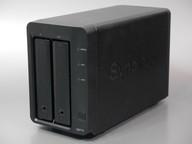Build the strongest photo storage environment with Amazon "Prime Photo" x Synology NAS
A NAS is a smart choice for storing large numbers of photos taken with your smartphone or digital camera. Most NAS on the market today have a terabyte-class capacity (or you can install an equivalent drive yourself), so you can store a large amount of high-resolution data and access it not only from a PC on the LAN, but also from a smartphone or tablet. can. Also, if it is a NAS with 2 or more drives, it is easy to recover even if a drive fails by forming a RAID (excluding RAID 0). This is not the case with a single-drive HDD or burning a CD/DVD for storage.
By the way, recent NAS, especially NAS made by Taiwanese manufacturers such as Synology, ASUSTOR, and QNAP, can expand their functions by incorporating various applications, one of which is synchronization with online storage. By synchronizing the NAS and the online storage, it is possible to cope with the loss of the NAS itself due to a disaster or theft, as well as the failure of the device itself that cannot be recovered with RAID. Since it is uploaded directly from the NAS to the cloud without going through a PC, there is no need to leave the PC turned on.

Also, by placing duplicates of photo data in online storage, it becomes easier to refer to them from outside. If the photos are stored only on the NAS at home, it is necessary to make settings such as dynamic DNS to refer to them from outside, but if there is a copy in the cloud, you can refer to it directly. That's why. It is perfect for utilizing past photographic assets, such as immediately looking for photos from that time and enjoying them on the spot when the topic of past events comes up at banquets with relatives, class reunions, drinking parties, etc.
This is a backup application provided for QNAP NAS. This is a backup application that can be installed from "AppCenter" and is prepared for NAS of ASUSTOR. A backup application prepared for the Synology NAS used this time that can be installed from "App Central". You can install it from Package Center. Compared to the previous two companies, there are fewer types because one application supports multiple online storagesNow, Synology was the first to support synchronization with Amazon Drive introduced at the beginning. NAS "DiskStation" series. Most manufacturers support synchronization with Dropbox, OneDrive, and Google Drive, but at least a few months ago when I built this environment, the "DiskStation" series supports synchronization with Amazon Drive. only (supported since DSM 6.0).
If you combine Synology's NAS "DiskStation" series with Amazon Drive (included in Prime Photos), the photo data saved on the NAS will be uploaded to Amazon Photos, and every time you add photo data, it will automatically can be effectively synchronized. Instead of regular backups such as once a day or once a week, it would be nice to have synchronization that is similar to mirroring. You can also select the direction of synchronization, so if you are using a dedicated app to upload photos directly from your smartphone or tablet to Prime Photos, you can also automatically download and sync them to your NAS.
The biggest advantage of this combination is capacity. Normally, compared to a NAS with a terabyte-class capacity, the online storage capacity is at most several GB to several tens of GB, so even if you don't upload all the NAS data, if you have a large amount of photo data For example, a paid contract to increase the capacity of online storage is unavoidable. However, since Prime Photo has unlimited storage, there is no running cost except for the annual membership fee for Amazon Prime, which is the eligibility for using Prime Photo.
